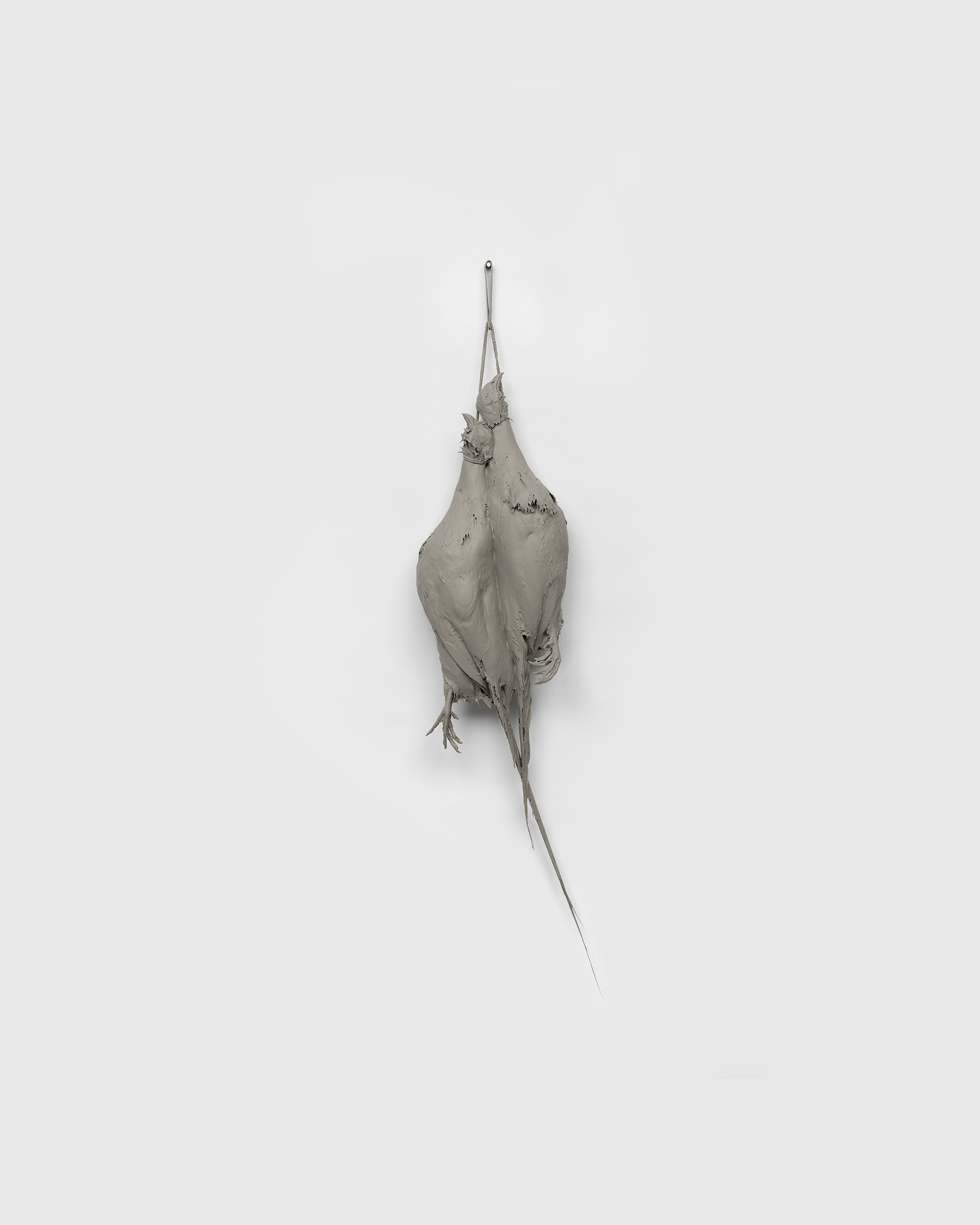
Gaylen Gerber, Support, n.d. Oil paint on taxidermy pheasants, United States, 20th century. 44 1/2 × 9 × 8 in. Courtesy of the artist and The Arts Club of Chicago.
A sampling of objets collected from across the globe—each object evenly coated in either grey or white oil paint—comprises Gaylen Gerber’s most recent body of work. While some harken from as early as four thousand years ago—as in the case of a second-century BCE Syro-Hittite divining mirror in the shape of a face—many items in this collection date from the nineteenth and twentieth centuries, an era scarred by colonial and post-colonial trauma. Gerber’s treatment and arrangement of the objects in the exhibition evoke a psychological framework haunted by the historical conditions that mark the objects on view.
A ceramic cup crafted in the image of a Peruvian god of the underworld, circa 800–900 CE, and painted grey by the artist, is exhibited in the foyer of The Arts Club of Chicago. The diminutive figure and the unpainted, engineered wood pedestal on which it rests are pushed to one side of the entryway; this sense of disarray mounts across the subsequent two galleries. From here, a set of glass doors open onto a room that is sparsely hung with a mirror, covered as in a house in mourning, but here with grey paint rather than drapery; a nineteenth-century Russian icon of Saint George slaying the dragon, painted white; and a 50-inch square canvas, painted white, which has been used in the past as a receptive surface for projected images by one of Gerber’s collaborators, Cindy Loehr. Since her passing, the canvas is shown alone—partial and incomplete— without Loehr’s accompanying projections. Unlisted on the checklist is a slight variation on the otherwise nearly uniform horizontal pedestals used in the exhibition; situated near the center of the room and without any object on display, it could almost be a coffin.
More boxy displays, placed at awkward angles and crowded in ways that make navigation meandrous, congest the second gallery space. An assembly of sixty some-odd additional painted objects sit and hang about the room. A sheer excess of objects associated with war, death, and burial populate the installation, among them: a cinematic prop of a Nazi scalp, used in Quentin Tarantino’s Inglourious Basterds (2009), painted white; an object described as either a mummy mask or false head, made from wood, textile, hair, and cinnabar, from Peru, painted grey; an Egyptian sarcophagus mask (664 to 332 BCE), painted grey; and a cinematic prop of a severed ear from the Hughes Brothers’ film Dead Presidents (1995), painted grey. At the back of the space are two taxidermic pheasants, hung from their necks against the wall, painted grey. The cool violence of these works overwhelms me. Those objects that don’t explicitly reference death, afterlife, or mutilation are often in some degree of disrepair, as with a Persian pitcher (750–1258 CE), painted white, that is chipped and broken in several places. Amidst so many indicators of loss, Gerber’s painted layers mark out the residues of suffering always present in the practice of culture.
The installation alludes to both a traditional artist survey (one which assembles works from an artist’s decade-spanning career) and a global art historical survey (which would include highlights from Eastern and Western art and design across centuries), but it finally performs as neither. Instead, these specters of exhibition formats are recalled only to be undercut by Gerber’s ongoing analysis of authorship and the institutions that historicize artists’ creative endeavors. The lighting, unconventional pedestals, scattershot arrangement, and most of all, the intervention of Gerber’s painting onto these objects distinguish the installation further from prior conventions. Following this larger pursuit, Gerber’s practice has often used painting as a means to apprehend the constitutive forms of exhibition and display and with them the cultural constructions of art, the ways art is appreciated, and the rote subject positions presupposed within this configuration.
In Gerber’s Untitled, Backdrop, and Support works of the past thirty years, grey and white monochromatic paintings blend in with the surrounding architecture of exhibition spaces and the less visible machinations of power, control, and regulation that support the presentation of art. In much of this work, Gerber has highlighted the exteriority of his artworks through painting (on canvases, exhibitions, and the rooms that house them) in ways that have shown especial receptivity to the projected meanings the work invites from viewers. A discourse populated by associations from anyone except the artist ensues around these works. Generally, his projects have confounded any moments in which his desires, latent or otherwise, might be made understandable to audiences.
But while the installation at The Arts Club is produced using similar formal tactics, these new Supports mark a departure in Gerber’s long reliance on his manipulation of default forms of art and its display (square canvases and blank walls, for example). While this system of titling his work Supports has indicated the significance of his paintings’ supports—that is, the substrates and surfaces on which they are painted—other more cognitive conceptions of support are stirred through this assembly. In addition to the deathly themes aforementioned, many of the objects on view were originally made for protective purposes, as with the four twentieth-century Tchitcheri Sakwa (protective figures), all attributed to the Gurma, Moba, Togo, and Ghana peoples, all painted white. Here, his Supports have been made to hold something inside of them, intimately sealed into the paintings as internalized objects. The suggestively mordant subtexts of the objects that Gerber brings together, combined with his interventions onto them, leads us to the crux of this body of work: the confusing and all too real paradox of a gesture that is both violent and loving at once.
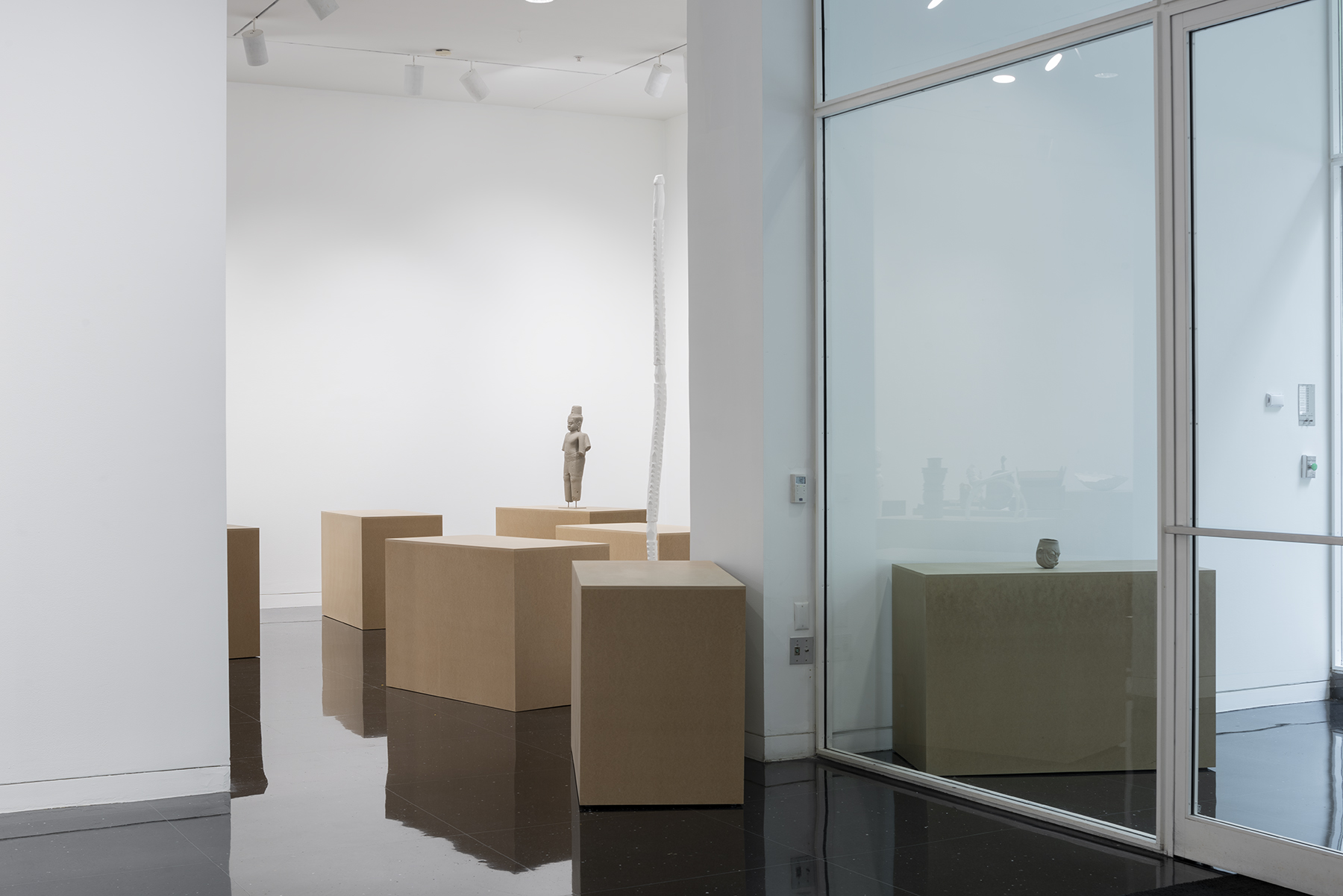
Gaylen Gerber, installation view, The Arts Club of Chicago, September 20–December 21, 2018. © The artist and Paul Levack.
Gerber’s career has been preoccupied with an ongoing examination of the ways that artists and art institutions interrelate, mostly as a means to question how surrounding contexts structure an individual psyche. At what point does the regulation of meaning around artworks and their makers within institutional settings constitute abuse (of power)? His pursuit of these inquiries relies on painting—that most praised and maligned of methods. Across several decades, the project of painting has received a deconstructive treatment typical of postmodernism’s tendency to disorder and scrutinize the constitutive features of a given medium. In the 1980s and early 1990s, Gerber made 38-inch square canvases painted in several smoothly applied shades of grey oil paint only subtly differentiated from one another. The museums, galleries, and auction houses that have played host to these works call them still life paintings, without ever venturing to name what is depicted. When I stare at these canvases in person (the Art Institute of Chicago owns several), I detect tonal differences arranged in soft groupings reminiscent of compositions by Georgio Morandi or Paul Cézanne, but without any specific imagery. These canvases of Gerber’s appear to merge the traditional grisaille technique of greyscale underpaintings with the twentieth-century appetite for monochromes, which dates from Kazimir Malevich’s Black Square (1915). They call into question fundamental variables in the design of paintings: abstraction and representation along with a litany of formal considerations, such as figure/ground relationships, color, light and shadow, composition, and surface texture. Gerber refigured all these elements into a continuousness that bordered on sameness. As with the rest of his oeuvre—including the exhibition at hand—Gerber inventories his works with “n.d.” (no date) rather than a specific year of completion. Undated, Gerber’s output is released from the hold that a tidy chronology and historical context exact over painting and other artistic production.
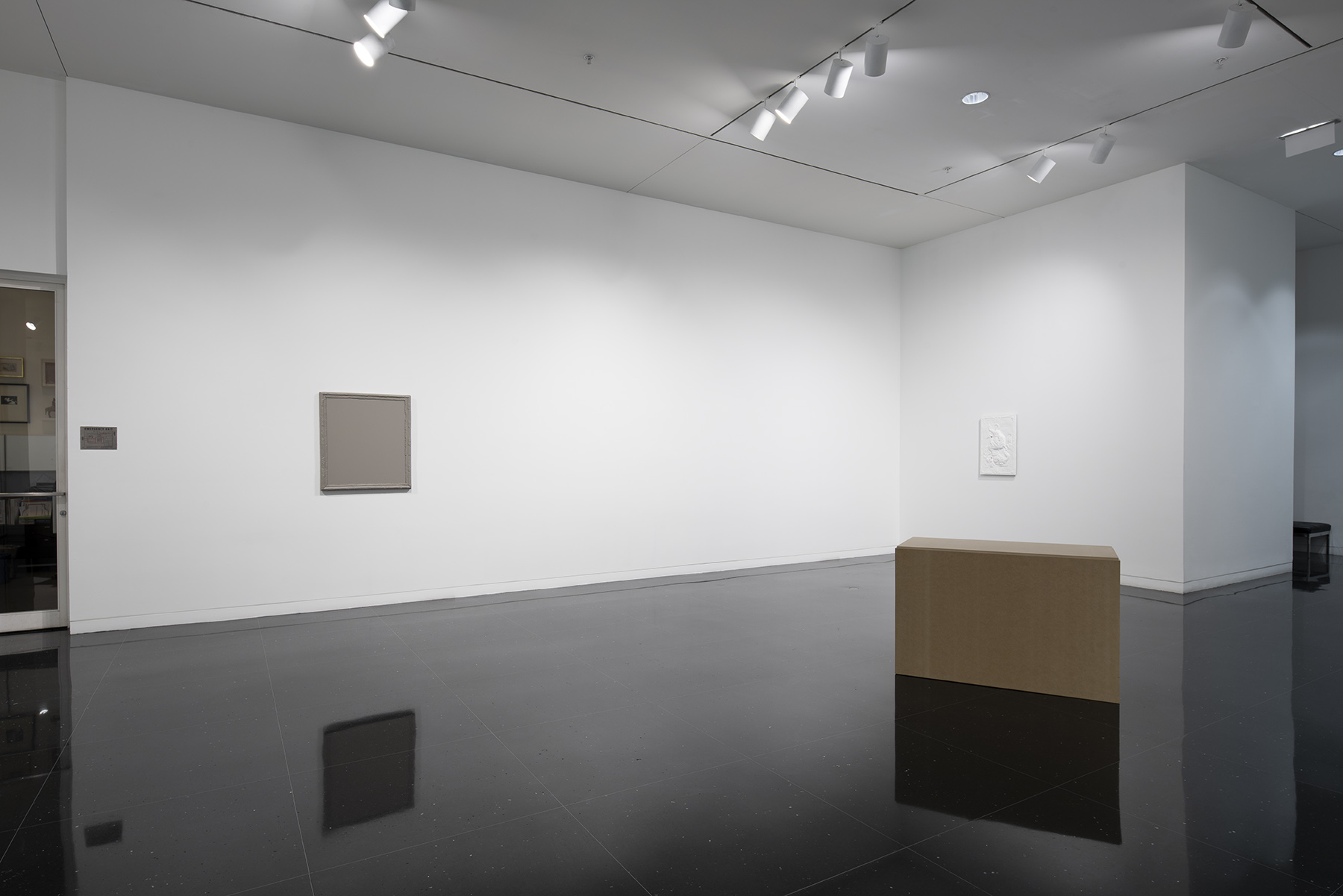
Gaylen Gerber, installation view, The Arts Club of Chicago, September 20–December 21, 2018. © The artist and Paul Levack.
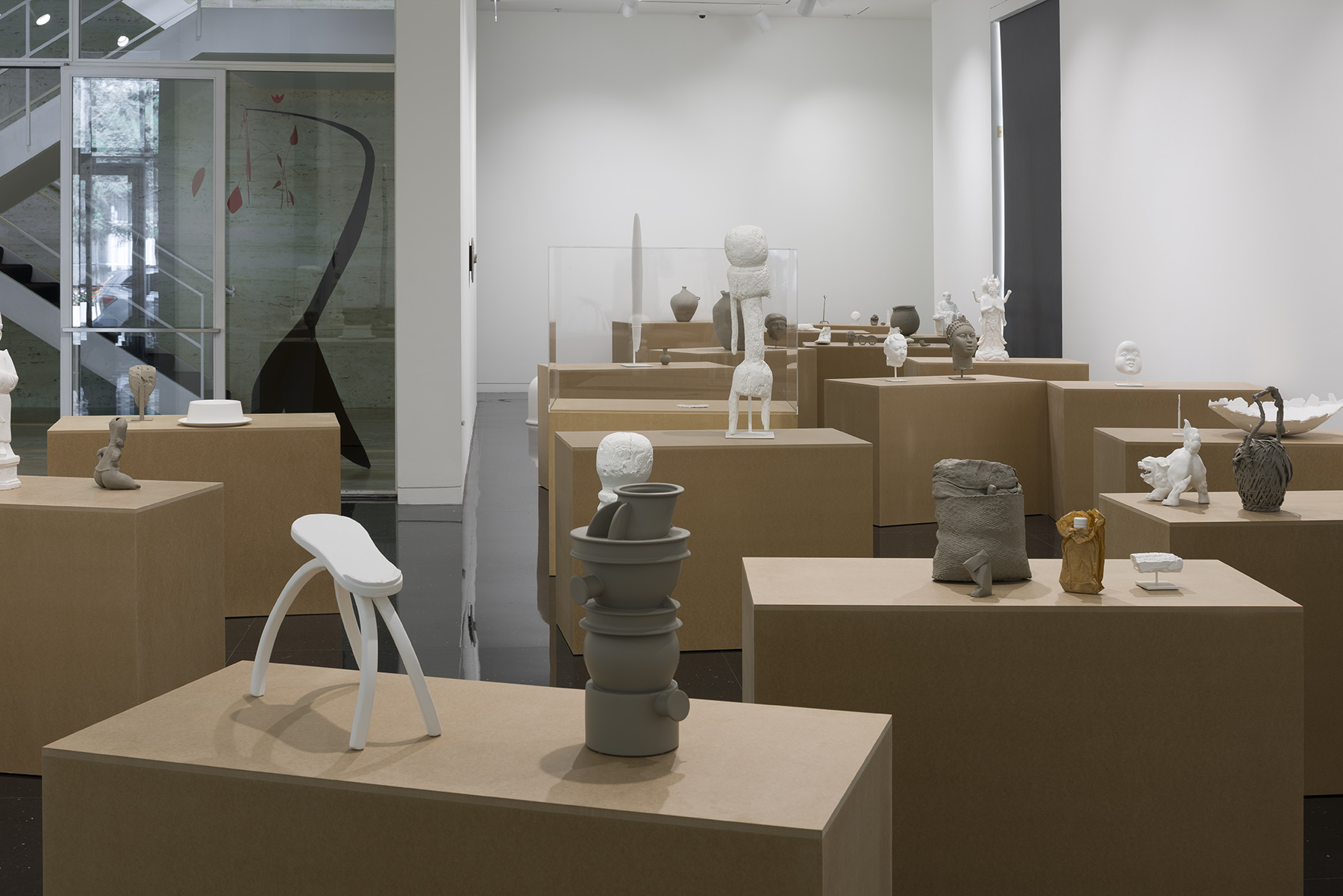
Gaylen Gerber, installation view, The Arts Club of Chicago, September 20–December 21, 2018. © The artist and Paul Levack.
Around the mid-1990s, Gerber produced the Backdrop works, in which the walls of exhibition spaces succeeded painted canvases as his preferred site of intervention. Sometimes painted directly onto walls and sometimes produced by pinning grey backdrop paper up across a gallery’s architecture or by building immense canvases that fully cover the walls onto which they are placed, these installations further diffused Gerber’s subtle painterly gestures into exhibition spaces themselves. More often than not, these Backdrop projects have been presented with artworks by other artists hung on them. Inserted between the recognizable forms of museum and exhibited artwork, Gerber’s Backdrops are gestures of immersive proportions. Thus, the artist leverages his position and his name in a series of maneuvers aimed to render visible some of the most reliable tools of hegemonic power: the presumed neutrality of occupying a centrist position, the ease with which claim is laid over cultural material, and the aesthetic tactics of remaining all but invisible. Unclear but clearly provocative, the works tested whether the camouflaged operations of institutional forces could be made manifest before the artist disappeared altogether into his imitations of the systems in which he and his work circulate.
Around the time of the Backdrop works (Gerber’s chronology is always speculative) the earliest Support pieces began as paintings made in cooperation with other artists. Gerber and his collaborators passed canvases back and forth, often with his counterparts applying paintings over warm grey grounds Gerber had prepared. Thus, the painted object became a site upon which complex networks within the field of art were mapped. The works foregrounded relationships— untidy overlaps of collegial, professional, and particularly personal connections—and revealed the individual constructed from those intersecting forces as an extension of the system in which she or he occurs.
Gerber’s practice never fully divests his authorship but rather unsettles it through roleplay. In the installation at The Arts Club, the position of artist annexes those of collector, cultural historian, and even anthropologist, with a view toward accounting for the ways the study of human culture always affects the examined materials. Despite his use of the aesthetic and rhetorical means by which institutions are established as authors of dominant cultural narratives, Gerber never takes institutional critique as his endgame. Rather, these structures serve as means to interrogate subjecthood per se and the ways that institutionality is embedded within its interlocutors.
Were Gerber’s practice to be measured solely for the way it reflexively questions power at institutional scales—how social privilege, class, commodification, and control over political agency are entrenched in systems of art—then it would seem that the artist who helms these inquiries would necessarily relinquish his disconcerting (but potentially lucrative) position as producer/product. That these projects gather under the sign of “Gaylen Gerber” indicates that the stakes of this practice are based on a set of personal psychological relations. In Gerber’s exhibitions, viewers are made to witness, however subtly, a circumspect demonstration of the maintenance and protection of a psychic life. At The Arts Club, particular attention is paid to moments of breach, fragmentation, and the threat tacit in being granted subjecthood of having that recognition once again withdrawn. Assaults on bodies and their psychical faculties are recorded in the forms of many of the objects on view, from the tragicomic, as in the inclusion of a beheaded rubber chicken (twentieth century, United States, painted white), to more stoic ruins, as with the battered Northern European limestone head of a provincial male figure (late Roman Empire, circa third–fifth century CE). While creamy white paint encases the general surface distress on this head, an errant hole bored into the face, barely an inch from its right eye, remains strikingly visible. As with so many of the installation’s elements, these fractured objects manifest the ways consciousness has been represented in art history. If the ego has been figured within psychoanalytic traditions as possessed of a self-conscious interior and point of view, the concept is also characterized with fraught potentialities for anxiety, abandonment, emasculation, and, most terminally, death. At stake are the ways that loss can be made meaningful.
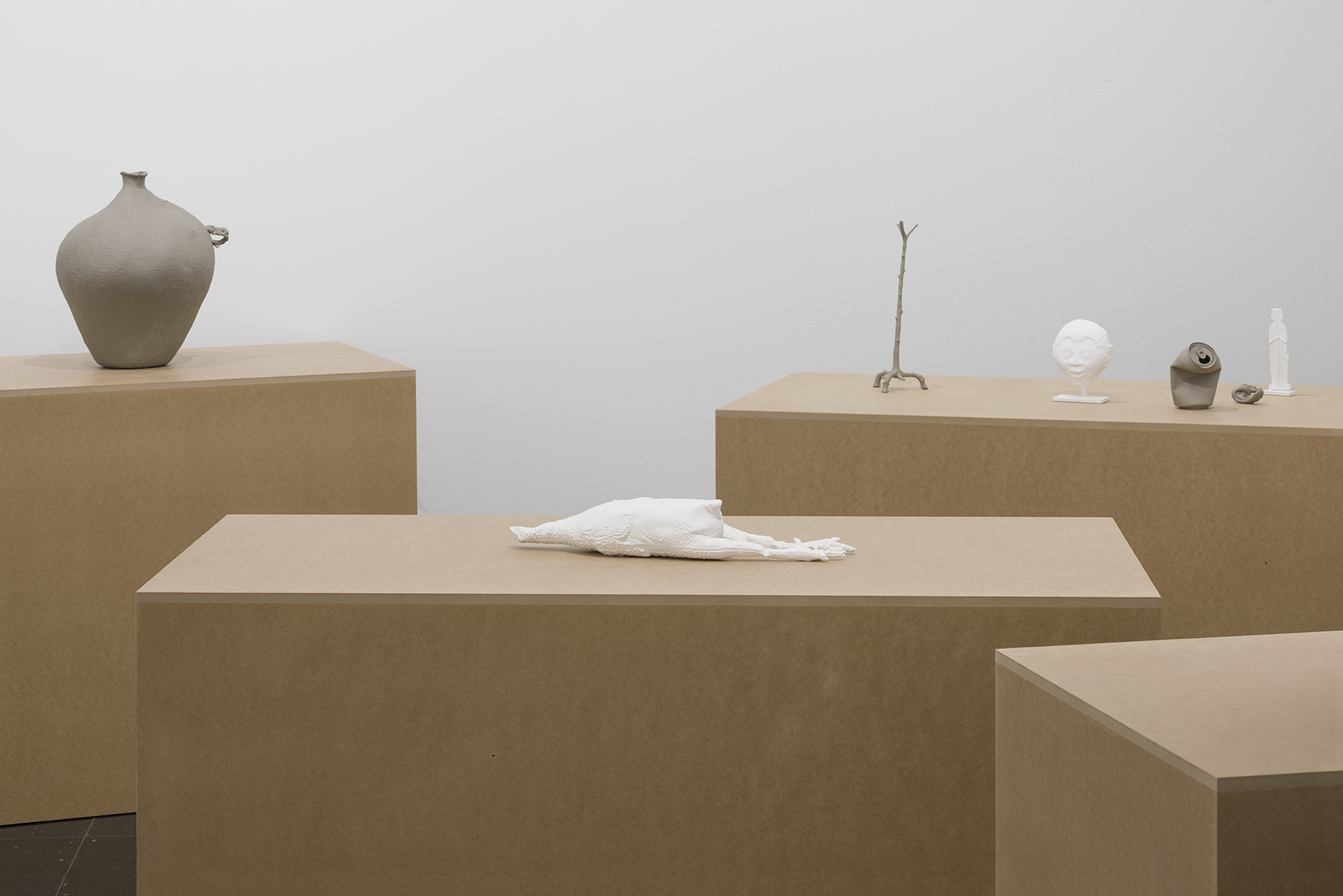
Gaylen Gerber, installation view, The Arts Club of Chicago, September 20–December 21, 2018. © The artist and Paul Levack.
There are considerable risks here, of course. First impressions show the installation to be an assembly of objets from across the planet—Asian figurines, such as a Chinese ceramic funerary figure (fifteenth century), whose head and hands appear worn down by the intervening centuries; African wood carvings, including an over-eight-foot tall tent post from Niger, carved with notches like vertebrae; crafts produced by indigenous North American tribes before and since colonization, for example a Navajo earthenware smudging pipe (1910); sculpture from the Middle East and the Global South; European design objects, such as a footstool attributed to Adolf Loos (circa 1905) and Ettore Sottsass’s Euphrates vase for Memphis Milano (1983); and twentieth- and twentyfirst- century Americana, including a pair of leather-and-cloth clown shoes and a crumpled aluminum beer can—all painted in either Gerber’s signature warm grey or, rather disconcertingly, a blank whitewashing. In a period of renewed sensitivities to cultural appropriation and the potential for abuse in modes of representation in the areas of race, nationality, and ethnicity, the operation of “the collector,” even at its most abstract, excites questions directly concerned with our society’s continued philosophical adherence to systems of property ownership. In contrast to Gerber’s earlier Support projects, which were multidirectional activities among collaborators—in which Gerber’s painting is painted over by a peer, or he covers over a painting by an artist cooperating with his invitation—each of the items on display at The Arts Club appears to reiterate a singular teleology by which objects are acquired and then painted into conformity with Gerber’s aesthetic project. The connoisseur, as Gerber performs the role, is a historical consequence of the catastrophic project of colonialism: the impulses to own, control, and economically exploit that have carved up the planet and its peoples serve as support for the construction of a globally-inflected palate among tastemakers and authors of art canons. Those violent tendencies run deep within the very framework of art history and exhibition practices. Gerber’s installation isolates those problems without extracting them altogether and calls attention to the as of yet totally unclear delineations between artists’ uses of found objects, readymades, and appropriative strategies throughout the last century.
It may be useful to read Gerber gathering and painting over this panoply of cultural forms as gestures that disrupt long-held assumptions of the relative neutrality of the tasks of collecting and curating within art institutions. In his work, what might appear as a re-inscription of the institution that is external to him is rather an effort to give material presence to internal, cerebral structures. This figuring of subjectivity as the primary site of trouble occurs in parallel to the work of Andrea Fraser and her own shift from institutional critique to something closer to a publicly performed psychoanalytic investigation. Fraser remarks, “We carry, each of us, our institutions inside ourselves. There’s a museum in here, inside of me . . . There are objects and images, and there are texts, and there are voices explaining. There’s an archive that also contains my memories. And there’s a basement where I keep the things I don’t want to show.”1
To the extent that Gerber’s selection process signals his identification with the objects on view, these Support pieces indicate the artist’s willingness to be rendered legible despite his sophisticated abilities in escape artistry. But while legible, the fragmentary quality of the sheer number of objects to which he has related through painting defies coherence. Through the qualities of stasis and remove suggested by his painted shells around forms worn through age and use, Gerber holds a condition of brokenness in perpetual remembering. The introspection stays preoccupied with effects of rupture at the expense of proposing alternatives for relief or redress. In his reenactment of the forms and methodologies of art as it has served colonizing purposes, Gerber eschews a respectability politics in which he could be portrayed as noble, heroic, and morally correct, when doing so delays an effective conversation around justice. Rather, The Arts Club installation evidences the art world’s continued reliance on the power imbalances that museums and the globalized marketplace receive latently from their colonialist histories. There is no apparent operation in this work that is more corrupt in its freedom to exact and appropriate than what is already present in the entire enterprise of art as it is practiced.
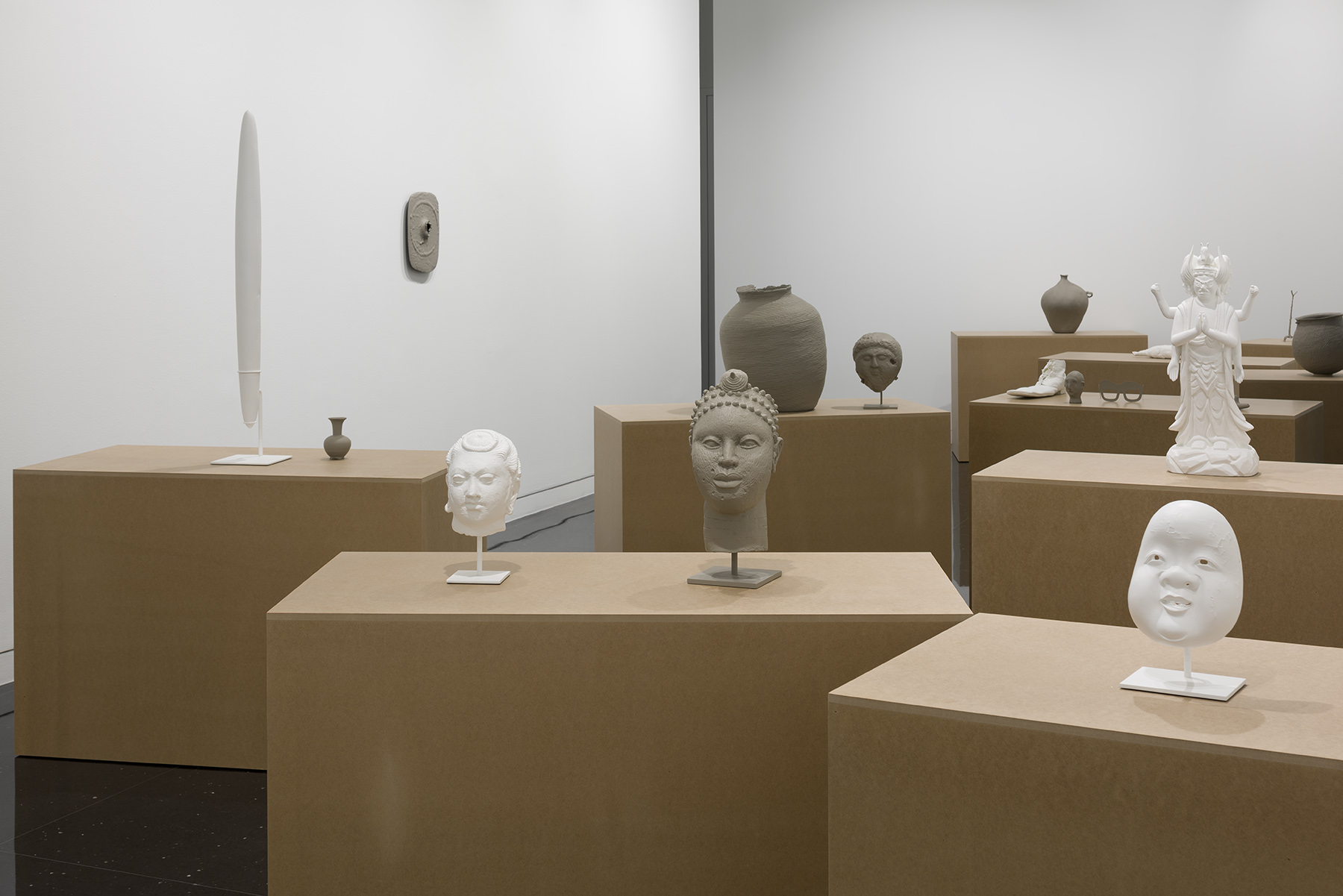
Gaylen Gerber, installation view, The Arts Club of Chicago, September 20–December 21, 2018. © The artist and Paul Levack.
Even the continued pervasiveness of white walls as neutral spaces for the display of art certainly depends on deeply held and historically instilled symbolism in which whiteness is figured as superior, central, and most pure. Gerber’s white paintings that resurface many of the objects on view extend this aesthetics of maintained cultural centrality that already orders the field of art. In this reflexive maneuver, Gerber objectifies whiteness in a way that it is rarely made to appear within cultural discourse. In manifesting whiteness as an interstitial operation within the field of art, Gerber makes it available for critique. But as hegemonic forces often do, to problematize white as a cultural sign of neutrality steps awfully close to reinscribing precisely the narrative of power that comes under examination. Those whitewashed objects on view serve as uncomfortable reminders of the ways artistic activity is and has always been supported by systems of wealth and exchange, accumulations of cultural capital, and positions of privilege (among them gender, nationality, and most of all race).
The reception of this work will tip precisely at the question of whether epistemological doubt over some of the most engrained features of art in its entirety is useful as direct political action. If analysis is unaccompanied by quantifiable social change, is it tantamount to complicity in violence? Yes, and in fact, even societal reform cannot be idealized beyond compromise formations and other subtler cruelties. Gerber takes brutality, conflict, and death as a starting point within the objects he has selected, and their staging, along with his white painterly interventions, serves as a useful tool for comprehending some of the pernicious ways that even our most tender psychological makeups are effected by power relations from across the globe and across centuries.
It is the rejoinder of grey that complicates the politics of Gerber’s array. In Gerber’s multiverse, love, death, trauma, and connection are most potent when not simply one thing or another. Differing in function, I believe, from his earlier grey work, here the shade serves as a starting point for counter-narrative. Disoriented from its prior usefulness as neutral par excellence, these grey fields abstract the objects that they surround. The grey produced is ambivalently outside the delimited imaginaries of white and black, a move that resonates as liberatory or threatening depending on the extent to which those rigid points of contrast are integral to a society’s need for definition through opposition. Gerber’s persistence across decades shows that grey is hardly a sign of impartiality or emptiness. Instead, grey is, at least, Gerber’s equivocality, a slippage among positions of artist, institution, architecture, and collector that seems always to signal excessively. Grey is Gerber’s jouissance.
The subtexts and sometimes the historical symbolism of these objects anticipate their alteration through being brought into Gerber’s work—that is, violence is already operative within the forms that the artist selects, not to mention implicit in their removal from their original contexts. If what he does to these objects is destroy them, it is iterative in a destruction that is, in most cases, already bound up in what the objects are: a slain dragon or a broken vessel, for instance. Likewise, visible everywhere is the reality that if this is a violation, it also follows upon a violation that happened before.
A few of the objects altered by Gerber are attributed to particular artists or designers. Among those on view are two porcelain panels by Lucio Fontana, both belonging to an edition of 75 works published by the German porcelain manufacturer Rosenthal, in 1968. These works, called Concetto Spaziale Cratere, combine mechanical and manual production, having been first cast in a mold and subsequently hand-punctured. They are hung at far ends of the second gallery, one white and the other grey. Each is a rectangle with rounded corners and an embossed circle like a target across the front. As in the gouged paintings for which Fontana became known, the middle of each piece is torn open, so that the white gallery wall is visible through them. The body of the clay lends the edge of these punctures a visceral, wounded quality.
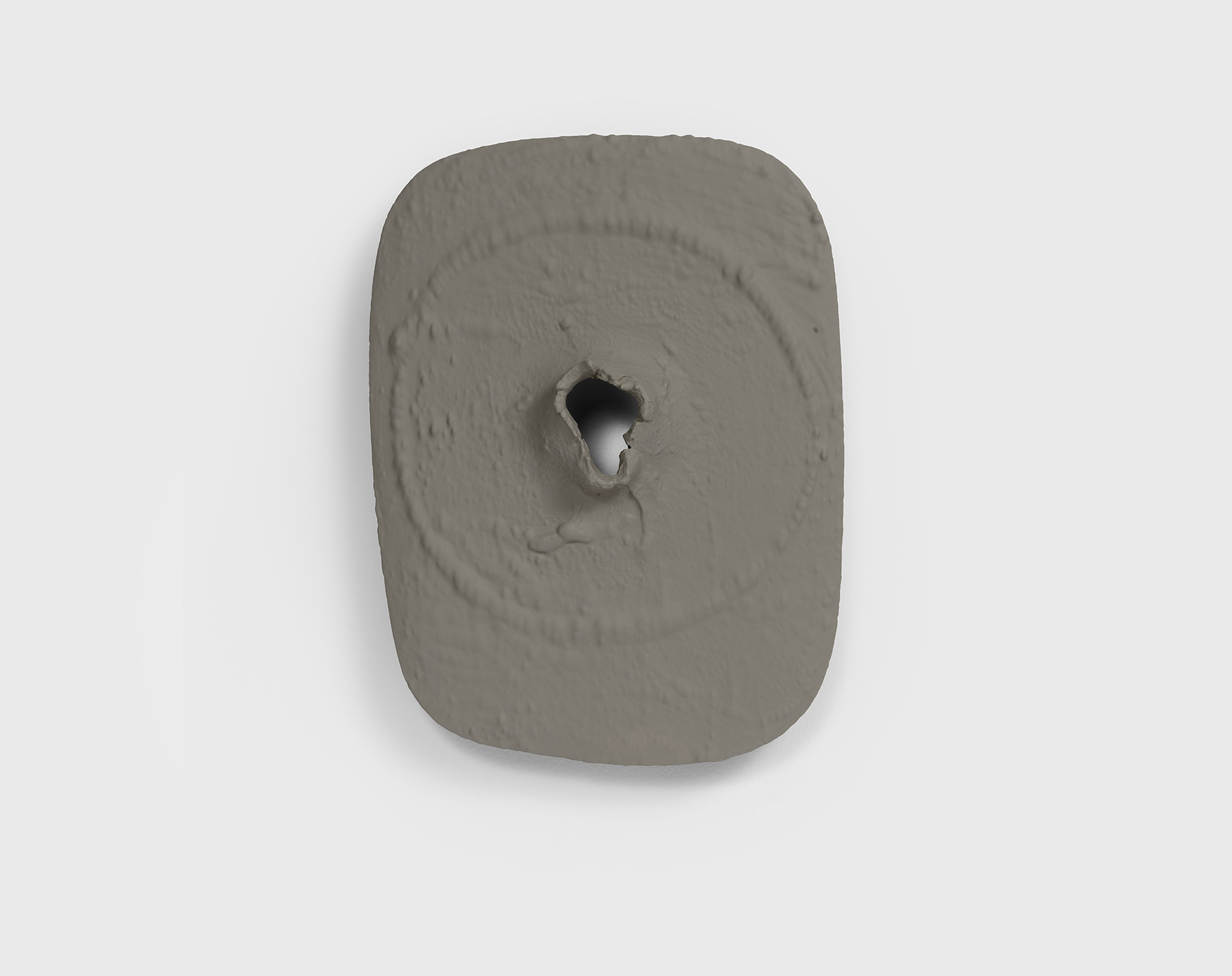
Gaylen Gerber, Support, n.d. Oil paint on Concetto Spaziale Cratere by Lucio Fontana, cast and hand-punctured porcelain, 1968. 15 × 11 1/2 × 3 in. Private Collection. Courtesy of the artist and The Arts Club of Chicago.
What is so striking in these Fontana Support works is how the visible action of the gesture legible in the final form precedes Gerber’s painting of it. His handiwork passes smoothly over all the surfaces of the work, carrying forward the actions wrought by hands prior to his own. Cast, then gouged, then auctioned, collected, and painted over, these works are solid indicators of the inherited trauma alluded to elsewhere in Gerber’s installation. The whole exhibition is filled again and again with reenactments of the same process of covering and holding. In each instance, remembering occurs, and what it aims to hold are things that are damaged and things that have been made to symbolize death and destruction. An infinitive introjection ensues in which all of these externalized objects are internalized, with Gerber presumably also altered by his identification with them. In coating these objects, their former lives are breached and then closed off from some presupposed futures, redirected into this collection. This is museological at its most psychological. This could be love, the sort of love Rihanna sings that we find “in a hopeless place.” 2
Matt Morris is an artist, writer, and novice perfumer. He lives in Chicago with two grey cats.
